This appendix contains brief descriptions and considerations associated with individual strategies for stakeholder engagement. The appendix draws from an overview of stakeholder engagement strategies developed by Kearns and West and the Center for Ocean Solutions during the information gathering phase of the Master Plan amendment process (Kearns & West and Center for Ocean Solutions 2017 (PDF)(opens in new tab)). As with the other appendices, it is anticipated this overview will continue to be expanded and refined as part of Master Plan implementation so it can serve as an effective resource to managers and stakeholders.
The overview was developed with the input of a range of stakeholders, including commercial Halibut, Herring, Spiny Lobster, and Sea Urchin fishermen. Recreational Abalone, Commercial Passenger Fishing Vessel (CPFV), private vessel, kayak, spear, and pier fishermen also provided input, as well as NGOs. Table G1 provides guidance on which strategy may be most effective at achieving the possible management goals as outlined below and further discussed in Chapter 4.
Potential strategies are organized into two groups: passive strategies and active strategies. Passive strategies do not require direct engagement with individual stakeholders, are generally easier to conduct, and have the potential to reach large audiences. Passive strategies provide less feedback and do not necessarily build the same relationships or engage or empower stakeholders to the same degree as active strategies. They are often best used when the engagement need is purely focused on information sharing. Active strategies provide a better chance of receiving information and engaging stakeholders in meaningful ways. Active strategies, however, typically require greater effort and need to be carefully planned to ensure the engagement is effective.
Passive Engagement Strategies
Blogs
Description:
- Blogs are an internet-based method for writing informally about management status and processes. Managers use blogs to share information and ideas.
- Comments can provide a forum for more active engagement, but must be carefully moderated, which can significantly increase workload and effort.
Purpose:
- Managers can use blogs as an online Frequently Asked Questions message board, increase the visibility of management staff perspectives, and highlight current management interests and concerns.
- Stakeholders can use blogs to highlight their own perspectives and share information, updates, and ideas about the marine resource.
Required resources:
- Staffing: Low – Medium
- Write blog posts and, if needed, respond to comments on a regular basis.
- Budget: Low
Emails
Description:
- Emails typically include relatively brief messages used to inform or share information with intended recipients. Emails may also contain attached documents. Recipients may range from individuals to large groups of stakeholders accessed via a listserv.
Purpose:
- Personal emails to key individuals can help build relationships and create two-way dialogue between active marine resource participants and managers.
- Mass emails to stakeholders and listservs can serve to efficiently disseminate timely information to a targeted audience.
Required resources:
- Staffing: Low
- Budget: Low
Newsletters
Description:
- Electronic newsletters can be used to disseminate information to a large number of stakeholders in a formal and consistent manner.
Purpose:
- Newsletters communicate a message to a large number of stakeholders (e.g., upcoming management changes or rulemaking processes).
Required resources:
- Staffing: Low – Medium
- Draft, vet, and send newsletters on a consistent, as-needed basis, and maintain and update the newsletter listserv contacts.
- Budget: Low
Phone Applications
Description:
- Phone applications provide cell phone users with a method to input information about marine resource conditions and catch, or to quickly and efficiently receive information.
Purpose:
- Phone applications provide a fast and easy method for managers to collect real-time data about resource collection, marine resource conditions, and socioeconomic and demographic information.
- Managers can use applications to disseminate timely information about updated resource regulations, current rulemaking processes, and other relevant information. Required resources.
Required resources:
- Staffing: Low
- Budget: Medium
Social Media
Description:
- Facebook, Twitter, Instagram, Flickr, and YouTube are examples of online social media tools that can be used to inform a large number of people (beyond those on existing listservs) of key information and increase the visibility of managers among specific stakeholder groups.
Purpose:
- Social media is a low-cost and efficient method for reaching a large number of people, including marine resource stakeholders who may be underrepresented in other engagement processes or the general public. Social media requires more effort to ensure it is current, interesting, and providing the information that users are seeking. It does not engage people who are more passively waiting for information to be delivered.
- Comments can provide a forum for more active engagement, but must be carefully moderated, which can significantly increase workload and effort.
Required resources:
- Staffing: Low – Medium
- Maintain social media accounts and current content. If applicable, respond to comments and manage dialogue.
- Budget: Low
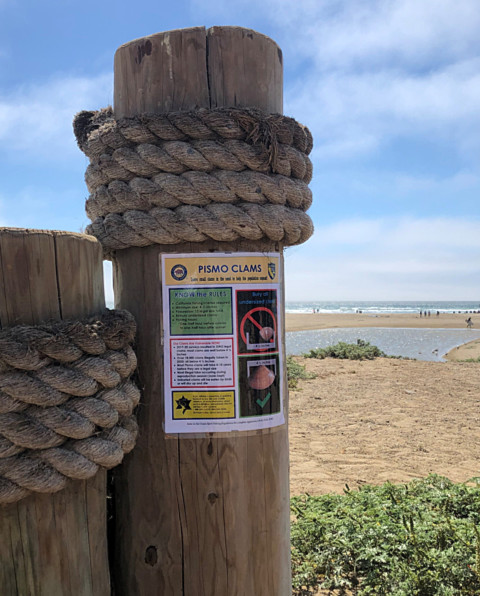 Pismo clam information sign posted in Morro Bay. (CDFW photo by Claudia Makeyev)
Pismo clam information sign posted in Morro Bay. (CDFW photo by Claudia Makeyev)
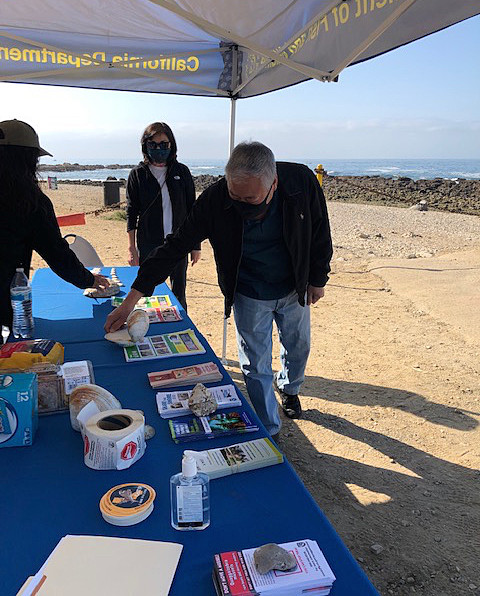 Tidepool outreach event held in the Palos Verdes area. (CDFW photo by Janice Munson)
Tidepool outreach event held in the Palos Verdes area. (CDFW photo by Janice Munson)
Printed Material (Pamphlets/Flyers/Posters)
Description:
- Educational and information pamphlets, flyers, and posters can be placed in locations where recreational and/or commercial fishermen are known to frequent (e.g., tackle shops, fuel docks, marine supply stores, and other marine-related businesses). Management information in the form of flyers or brochures can be placed at the check-out counter or storefront or posted on bulletin boards in these locations to disseminate details to stakeholders that may not have access to information shared electronically.
Purpose:
- Distribute timely information efficiently to a broad stakeholder audience. Sharing messages in this fashion is particularly helpful when the stakeholder groups are undefined, speak a different language, or are difficult to reach using electronic methods.
Required resources:
- Staffing: Low
- Develop, vet, and distribute flyers.
- Budget: Low – Medium
- Print and distribute materials.
Websites
Description:
- Websites are internet sites where structured and searchable information can be shared.
Purpose:
- Websites have the capacity to inform a large number of stakeholders about agency structure, process, and activities.
- Websites can have varying degrees of interactivity, including online comment sections, videos, live feeds, or links to other methods of engagement (e.g., blogs, newsletters, documents, etc.). Websites require people to seek information out and will not reach passive stakeholders who are expecting information to be provided more directly.
Required resources:
- Staffing: Low – Medium
- Maintain the website and generate material.
- Budget: Low – Medium
- Custom website designs and applications increase costs.
Press Releases
Description:
- Press releases are written or recorded communication directed at members of the news media to announce something newsworthy (often a major project milestone or regulatory decision).
Purpose:
- Press releases reach a broad audience quickly, inform members of the public about a major decision or milestone, and target individuals who may not otherwise be aware of marine resource management.
Required resources:
- Staffing: Low
- Budget: Low
Active Engagement Strategies
Written Public Comment
Description:
- Written public comment is an opportunity for members of the public to provide input (e.g., via email, letter, or online forum) on draft policy and regulatory documents. This can take place as part of a formal regulatory process. Resource managers can also solicit written comments on draft materials or concepts in the pre-regulatory phase.
Purpose:
- Public comment provides marine resource managers or agency staff with a formal written record of public opinion on a regulatory process.
- Public comment provides stakeholders with an opportunity to provide input to inform management decisions, both early in planning processes and during formal regulatory processes.
- Public comment does not necessarily require a response but can help influence responses at a later date.
Required resources:
- Staffing: Low – High
- Staff time for written public comment is entirely dependent on the number of comments received and on whether marine resource managers plan to, or are required to, respond to the comments (this acknowledges that agencies cannot always respond to all comments).
- At a minimum, one staff or project/regulatory lead and one support staff will be needed to manage, catalogue, and respond to public comments as they come in. Resource managers often contract these services out to an outside consulting firm to support large-scale efforts.
- Budget: Low – Medium
- For larger projects, likely will require use of external consultant.
- Assumes consultant would manage, catalogue, and respond to public comments as they come in.
Online Fishing Forums
Description:
- Online forums are similar to social media feeds targeted to a specific interest group. Proactive participation in forums allows staff to virtually meet stakeholders to exchange ideas and build an understanding of stakeholder interests.
Purpose:
- Online forums provide a venue to increase the visibility of management staff, promote agency messaging within trusted channels, and limit the proliferation of unclear or inaccurate information.
- Online forums, if not moderated by the agency, can often lead to ineffective, off topic, or even inappropriate engagement that is counterproductive to the intended use.
Required resources:
- Staffing: Low – Medium
- Budget: Low
Surveys
Description:
- An evaluation or information collection technique consisting of a series of questions designed to solicit opinions from stakeholders on specific marine resource management issues and/or to collect data (e.g., human dimensions of the resource or otherwise). Surveys can be distributed online or via hard copy to be completed in-person or mailed by the respondent at a later date.
Purpose:
- Surveys solicit input on a specific topic from a targeted list of stakeholders, such as evaluating the socioeconomic demographics of a marine resource or soliciting feedback on a proposal for a management alternative.
- Surveys need to be carefully designed to achieve the desired outcome and can suffer from low response rates, limiting their applicability in some cases.
Required resources:
- Staffing: Medium
- Budget: Low
Polling
Description:
- Polling samples or collecting opinions on a subject from either a selected or a random group of stakeholders. Polling can be done through a survey or real time using mobile devices (i.e., mobile polling).
Purpose:
- Polling is similar to surveys but with a greater level of specificity (usually a single or small number of questions). The purpose of a poll is to solicit input on a specific issue quickly.
- If taken in person, polling results can provide greater participation than simple surveys.
Required resources:
- Staffing: Medium – High
- Staff are needed to design, implement, compile, and interpret results of a poll.
- Budget: Medium – High
Phone Calls
Description:
- Phone calls are an opportunity for staff to communicate orally with individual stakeholders. These may be initiated by staff or the stakeholder.
Purpose:
- Phone calls provide staff with an informal opportunity to reach out directly to individual stakeholders to ask questions, receive input, and build relationships.
- Phone calls initiate two-way communication to test ideas on sensitive subjects; this may be useful in cases where stakeholders or marine resource managers do not feel comfortable creating a written record.
Required resources:
- Staffing: Low
- Variable depending on communication needs.
- Budget: Low
Conference Calls
Description:
- Managers engage a group of stakeholders remotely via telephone.
Purpose:
- Conference calls facilitate two-way dialogue between marine resource managers and stakeholders.
- They provide an efficient and accessible method of engagement by reducing the cost and travel time for participants.
Required resources:
- Staffing: Low – Medium
- Plan, convene, schedule and lead calls. Notes and summary documents are often provided after calls to provide a written record of the discussion.
- Budget: Low
Fishery Association Meetings
Description:
- Managers attend marine resource association meetings convened by industry associations or recreational marine resource users to make announcements and meet stakeholders.
- Association meetings usually involve their membership and may also include the broader resource user community.
Purpose:
- Attending association meetings provides marine resource managers with the opportunity to present and share information directly to resource users.
- Managers can receive input from resource users in an environment where they are likely to share information more freely than in a venue with more conflicting interests present (e.g., an advisory group).
- Attending association meetings is an efficient method for meeting marine resource users face-to-face and building relationships.
Required resources:
- Staffing: Low – Medium
- Effort depends on the number and location of meetings and level of pre-planning (e.g., presentation development).
- Marine resource association meetings are often 1-3 hours and take place close to the docks. Some meetings, however, are full days or even multiple days depending on the association and topic.
- Budget: Low – Medium
- Travel costs need to be considered.
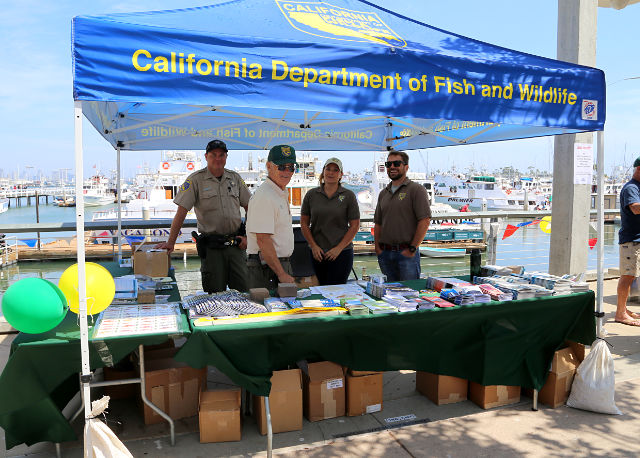 The CDFW booth at a Day at the Docks in San Diego. (CDFW photo)
The CDFW booth at a Day at the Docks in San Diego. (CDFW photo)
Trade Shows
Description:
- Trade shows are periodic events (typically annual) that bring together gear suppliers and resource users from commercial and recreational sectors. Agency staff can host a booth at trade shows to disseminate general information about and increase visibility of agency structure, process, and activities.
Purpose:
- Trade show booths can be used to target underrepresented stakeholder groups in conversation, distribute information about agency processes, and generally build trust and visibility among the general public. They are a good opportunity for agency staff to engage in informal, one-on-one discussion with interested resource users.
Required resources:
- Staffing: Low – Medium
- Plan for and attend trade shows. Frequency of attendance impacts staffing.
- Budget: Low – Medium
- Travel costs for staff depending on location, as well as any communication materials for dissemination and booth banners.
Informal Meet and Greets
Description:
- Small group or one-on-one discussions between marine resource managers and stakeholders, often located in public establishments close to the docks.
Purpose:
- Meet-and-greets provide marine resource managers with the opportunity to build personal relationships with individual marine resource users in an informal environment.
- They allow marine resource stakeholders to share concerns and input with marine resource managers in an informal environment.
Required resources:
- Staffing: Low (per meeting)
- One staff per meeting, with additional staff support as needed.
- Budget: Low
Listening Sessions
Description:
- Listening sessions are in-person meetings between managers and stakeholders focused on providing a venue for stakeholders to voice their interests and concerns. Managers are present primarily in a listening, rather than information presentation, capacity.
Purpose:
- Listening sessions help managers get a pulse on the range of options for crafting management alternatives, potentially identify creative management opportunities by introducing new perspectives and elevate the voices of underrepresented stakeholder groups.
Required resources:
- Staffing: Low – Medium (depending on the number of sessions)
- Budget: Low – Medium (depending on the number of sessions)
- Facilitation materials and travel costs for staff.
Open Houses
Description:
- Open houses are often structured in an open-floor format with different “stations” placed around a large room. Stakeholders may engage in dialogue with content experts and provide comment as desired.
Purpose:
- Individual stakeholders interact directly with agency staff and build relationships.
- Agency staff have the opportunity to learn of stakeholder issues and key concerns.
- Interested marine resource stakeholders become more knowledgeable about a specific rulemaking process.
Required resources:
- Staffing: Medium – High
- Develop materials, plan, and participate in the event.
- Budget: Low – High
- Outreach materials and travel costs for staff.
Webinars
Description:
- Webinars are virtual meetings with auditory and visual components that allow participants who may be geographically far from one another to share information and dialogue.
Purpose:
- Webinars can be used to communicate management options early in the rulemaking process, educate stakeholders about a particular issue, or electronically stream public meetings. More advanced webinars allow for breakout groups, instant polling, and other innovative tools to provide a high degree of stakeholder input and collaboration in virtual meetings.
Required resources:
- Staffing: Low – Medium
- Design, market, and manage webinars, plus staff time for individual presentation development and implementation per webinar.
- Budget: Low
Key Communicators
Description:
- Managers work with key members, usually leaders, of a marine resource community and other stakeholder groups as nodes for building trust, communicating with other participants within their marine resource community about management processes, and providing critical feedback on management options.
Purpose:
- By disseminating information to key communicators and requesting they distribute it to their representative communities, key communicators can help build relationships and ensure resource management information is distributed to and received from key stakeholders.
- Key communicators provide a means of engaging hard-to-reach marine resource groups. They speak the same language as users, have established positive relationships within the particular resource community, and are sometimes seen as being able to speak for the group in question.
Required resources:
- Staffing: Low (variable effort depending on the project and how often communication is needed)
- At least one agency staff member per fishery who is aware of the relevant key communicators for that fishery and maintains contact with them throughout the management process.
- Budget: Low
Workshops
Description:
- In-person meetings (which can range in duration from one hour to two days) that are informal, problem-solving focused, interactive, and often involve a combination of small group and plenary discussions.
Purpose:
- Workshops provide marine resource managers and stakeholders with the opportunity to interact directly with each other in a small group format as well as in a standard, plenary format.
- Workshops are useful spaces for brainstorming, sharing ideas, joint-problem solving, and trust and relationship building.
Required resources:
- Staffing: Medium – High
- Workshops tend to be staff intensive, although time for planning and implementation may only be required over 2-3 months.
- Budget: Medium – High
- Often requires facility rental and use of contractors to assist with planning and facilitation. Travel costs for staff.
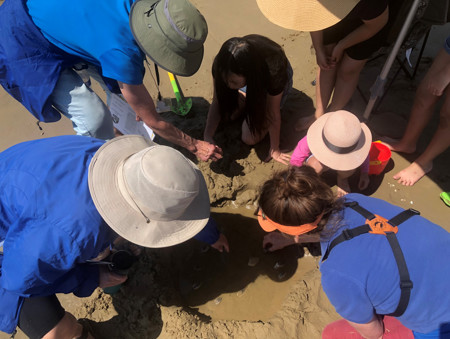 Volunteers learning to rebury pismo clams during a State Parks and CDFW outreach event. (CDFW photo by Claudia Makeyev)
Volunteers learning to rebury pismo clams during a State Parks and CDFW outreach event. (CDFW photo by Claudia Makeyev)
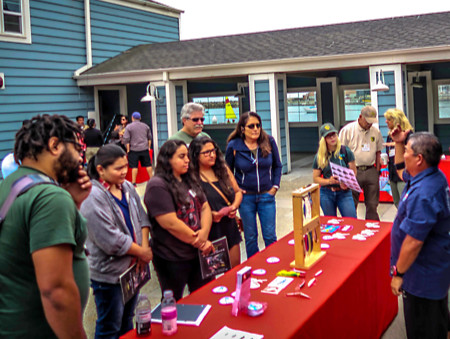 California Fishing Passport collaborative outreach event. (CDFW photo by Carrie Wilson)
California Fishing Passport collaborative outreach event. (CDFW photo by Carrie Wilson)
Education Programs
Description:
- Education programs train stakeholders and increase their understandings of the management process and capacity to engage in scoping or revising management rules.
- Education programs can occur over single or multiple days with the goal of training key stakeholders in how to engage effectively, participate in management processes more generally (e.g., rulemaking 101), and where attendees are given the opportunity to socialize with other stakeholders and agency staff.
Purpose:
- Education programs increase stakeholder understandings of management and engagement processes and thereby better equip them to more fully participate in dialogues about the resource and take on leadership roles.
Required resources:
- Staffing: High
- Dedicated staff to develop, implement, and manage the educational aspects of agency decision-making processes.
- Budget: Low – High
- Depends on facility needs and curriculum development.
Town Halls
Description:
- Town hall-style meetings are open, public meetings often structured around a brief presentation on a specific topic followed by time for questions and discussion.
Purpose:
- Town halls give stakeholders an opportunity to speak freely about a specific or general issue of management concern. They can also be structured to disseminate information to a geographically-specific stakeholder community. They are helpful during rulemaking processes or while implementing a management policy as a means of disseminating information and clarifying uncertainties among geographically-specific communities.
Required resources:
- Staffing: Medium – High
- Develop materials, plan, and participate in the event.
- Budget: Low – High
- Outreach materials and travel costs for staff.
Public Hearings/Testimony
Description:
- Public hearings are opportunities for members of the public to provide verbal testimony at formal public meetings or as part of a regulatory process.
Purpose:
- Public hearings provide marine resource managers or agency staff with a formal spoken record on a regulatory process.
- They provide stakeholders with a formal opportunity to provide input to inform management decisions.
Required resources:
- Staffing: Medium – High
- Public hearings often require high-level staff and support staff.
- Budget: Low – High (depends on whether external facilitation is needed and how many meetings are involved)
- Low (if a single meeting and if convened and facilitated by an existing Board or Commission)
- Medium – High (if multiple meetings, facilities, and external facilitation are required)
Stakeholder Advisory Groups
Description:
- Stakeholder advisory groups are multi-interest bodies of appointed stakeholders convened for a pre-determined period of time to provide individual or collective advice to a decision-making body. Stakeholder advisory groups can serve to identify key issues, generate management alternatives, or liaise between managers and advisory group constituencies. They typically have charters describing their core charge and participants, and can meet once or multiple times.
- There are two kinds of stakeholder advisory groups:
- Standing stakeholder advisory groups (often required by statue or regulation):
- Typically focused on a particular fishery.
- Typically meet at set intervals throughout a year.
- Formalized, rotating membership.
- Ad hoc stakeholder advisory groups:
- Typically focused on a particular policy, planning, or regulatory issue.
- Typically convened for multiple meetings. May range from a few months to multiple years.
Purpose:
- For either standing or ad hoc advisory groups, the purpose is to solicit collaborative input from a group of individuals representative of larger interest groups (e.g., fishing industry, NGOs,challenges.
Required resources:
- Staffing: High
- Staffing assignments are largely dependent on the size of the group in question. For smaller advisory groups, a single staff member, one support staff, and one group facilitator may be sufficient. Larger groups may require additional staff to support group activities.
- Budget: High (assuming at least four advisory group meetings)
- Cost will depend on the number of meetings and the complexity of the advisory process.
- Third-party, neutral, professional facilitation is often necessary.
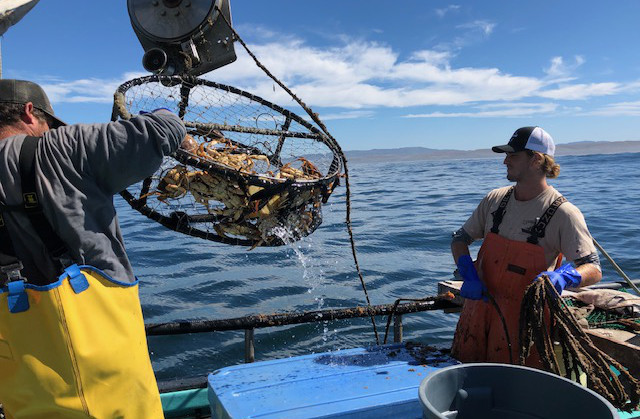 Testing new crab pot. (CDFW photo by Christy Juhasz)
Testing new crab pot. (CDFW photo by Christy Juhasz)
Collaborative Fisheries Research
Description:
- Managers, researchers, and fishermen co-design and co-conduct research to assess marine resource status or test a management option. Note that the engagement component of CFR is secondary to the primary purpose of conducting research.
Purpose:
- CFR evaluates hypotheses around the efficacy of various management alternatives or tests specific management-relevant technology.
- CFR serves to engage marine resource stakeholders with relevant context or expertise in a rigorous and intensive process of formulating research questions and executing research design, thus fostering and building relationships and trust in the process.
- CFR increases buy-in and ownership of the decision-making process, increases transparency around the use of data in decision-making, improves the valuation of scientific information in decision-making, and motivates co-development of management goals.
Required resources:
- Staffing: High
- Budget: High
Table G1: Engagement strategy effectiveness for achieving specific engagement goals (adapted from Kearns & West and Center for Ocean Solutions 2017).
| Engagement strategy
|
Build trust
|
Efficiency educate
|
Build relationships
|
Engage underrepresented stakeholders
|
Socioeconomic
|
Research
|
Inform
|
Solicit input
|
Involve
|
Collaborate
|
Empower
|
| PASSIVE STRATEGIES
|
| Blogs
|
SL
|
ML
|
SL
|
LL
|
LL
|
LL
|
ML
|
SL
|
SL
|
LL
|
LL
|
| Emails
|
SL
|
SL
|
SL
|
ML
|
SL
|
LL
|
ML
|
SL
|
SL
|
SL
|
LL
|
| Newsletters
|
LL
|
SL
|
SL
|
ML
|
SL
|
LL
|
ML
|
LL
|
SL
|
SL
|
LL
|
| Phone applications (Apps)
|
LL
|
ML
|
LL
|
LL
|
LL
|
ML
|
ML
|
LL
|
SL
|
LL
|
LL
|
| Social media
|
SL
|
ML
|
SL
|
SL
|
ML
|
LL
|
ML
|
ML
|
ML
|
LL
|
LL
|
| Printed materials
|
LL
|
SL
|
LL
|
LL
|
ML
|
LL
|
ML
|
LL
|
SL
|
LL
|
LL
|
| Websites
|
LL
|
ML
|
LL
|
LL
|
LL
|
LL
|
ML
|
LL
|
LL
|
LL
|
LL
|
| Press releases
|
LL
|
ML
|
LL
|
LL
|
LL
|
LL
|
ML
|
LL
|
LL
|
LL
|
LL
|
| ACTIVE STRATEGIES
|
| Written public comment
|
LL
|
SL
|
LL
|
LL
|
LL
|
LL
|
LL
|
LL
|
SL
|
LL
|
LL
|
| Online fishing forums
|
SL
|
SL
|
LL
|
SL
|
SL
|
LL
|
ML
|
SL
|
SL
|
LL
|
LL
|
| Surveys
|
LL
|
ML
|
LL
|
LL
|
LL
|
ML
|
LL
|
LL
|
LL
|
LL
|
LL
|
| Polling
|
LL
|
SL
|
LL
|
LL
|
LL
|
ML
|
LL
|
LL
|
LL
|
LL
|
LL
|
| Phone calls
|
SL
|
SL
|
LL
|
SL
|
SL
|
LL
|
ML
|
SL
|
LL
|
SL
|
LL
|
| Conference calls
|
LL
|
ML
|
LL
|
SL
|
LL
|
LL
|
ML
|
SL
|
SL
|
LL
|
LL
|
| Fishery association meetings
|
ML
|
ML
|
SL
|
ML
|
LL
|
LL
|
ML
|
SL
|
SL
|
LL
|
LL
|
| Trade shows
|
SL
|
SL
|
LL
|
SL
|
ML
|
LL
|
ML
|
SL
|
LL
|
LL
|
LL
|
| Informal meetings
|
ML
|
SL
|
SL
|
ML
|
ML
|
LL
|
ML
|
ML
|
ML
|
LL
|
LL
|
| Listening sessions
|
SL
|
SL
|
LL
|
SL
|
SL
|
LL
|
SL
|
ML
|
SL
|
LL
|
LL
|
| Open house
|
ML
|
ML
|
ML
|
ML
|
SL
|
LL
|
ML
|
SL
|
SL
|
LL
|
LL
|
| Webinar meetings
|
SL
|
ML
|
SL
|
LL
|
LL
|
LL
|
ML
|
SL
|
SL
|
LL
|
LL
|
| Key communicators
|
ML
|
ML
|
ML
|
ML
|
ML
|
LL
|
ML
|
ML
|
ML
|
LL
|
LL
|
| Workshops
|
SL
|
SL
|
SL
|
SL
|
LL
|
LL
|
ML
|
ML
|
ML
|
SL
|
LL
|
| Education programs
|
ML
|
ML
|
ML
|
ML
|
SL
|
SL
|
ML
|
ML
|
ML
|
LL
|
LL
|
| Townhalls
|
LL
|
SL
|
LL
|
SL
|
LL
|
LL
|
ML
|
LL
|
SL
|
LL
|
LL
|
| Public hearings
|
LL
|
SL
|
LL
|
LL
|
LL
|
LL
|
SL
|
ML
|
LL
|
LL
|
LL
|
| Stakeholder Advisory groups
|
ML
|
LL
|
SL
|
ML
|
ML
|
LL
|
ML
|
ML
|
ML
|
ML
|
SL
|
| Collaborative research
|
ML
|
LL
|
ML
|
ML
|
SL
|
SL
|
SL
|
ML
|
ML
|
ML
|
ML
|
Photo at top of page: Fishermen outreach program. (CDFW photo)